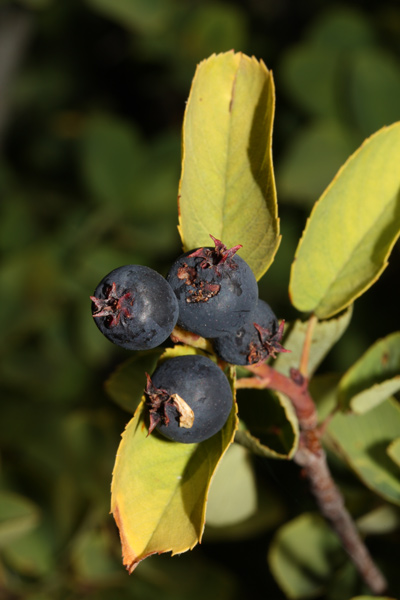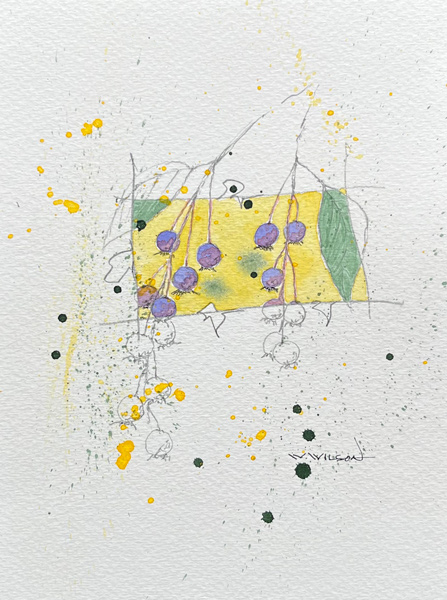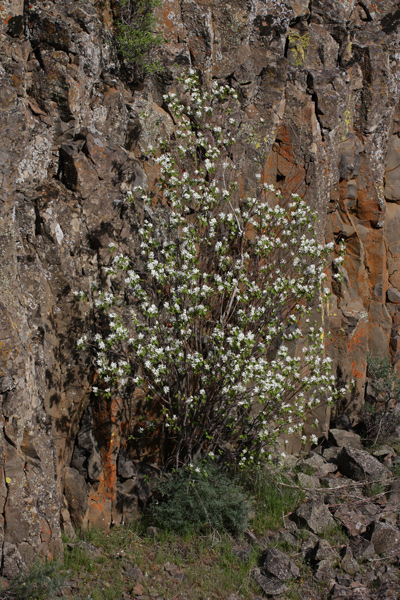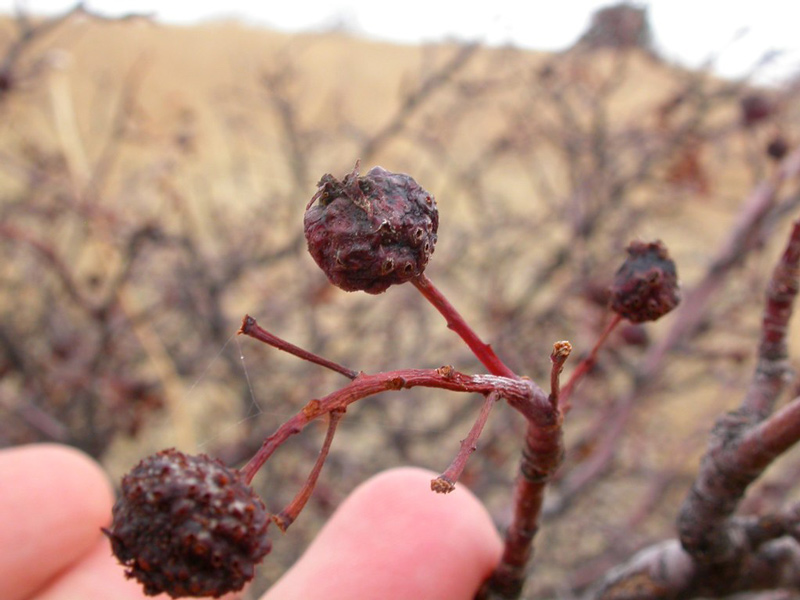Serviceberry
Amelanchier alnifolia
Skagit Bay, Washington, © 3 July 2009 by Walter Siegmund. Permission to use given via the Creative Commons Attribution-ShareAlike 3.0 Unported license.
“Servis berry valley”
Two and half months after leaving Fort Mandan with its relatively abundant supply of Mandan vegetables and fruits, the Lewis and Clark Expedition members supplemented their diet with fresh fruit picked from serviceberry bushes that were growing in present-day Helena valley. Further south in the Jefferson River valley, 3 August 1805, Sgt. Patrick Gass effused:
Currants and service berries are in abundance along this valley, and we regaled ourselves with some of the best I had ever seen.[1]The Definitive Journals of Lewis and Clark, Gary Moulton, ed., 10:121.
As the enlisted men poled and pushed the heavy dugout canoes up the increasingly diminishing river, those walking on shore had plenty of time to pick berries. The journalists credited Toussaint Charbonneau, Sacagawea, and William Clark for the refreshment collected on the Beaverhead River:
Capt. Clark our Intrepter & wife walked on Shore and found a great quantity of Servis berrys the largest & best I ever Saw. they gethered a pale full &C. Gave them out to the party at noon . . . . we name this place Servis berry valley.[2]John Ordway, 16 August 1805, Journals, 9:203.
Etymology
The journalists mention serviceberry 63 times spelling it 13 different ways. The name was already in use in the early United States and likely came from the European service tree, Sorbus sp. Some say that the name came from missionaries holding services in the bush’s shade.[3]Stephen R. Jones and Ruth Carol Cushman, The North American Prairie (Boston: Houghton Mifflin Company, 2004), 431. This is plausible as the French explorers pre-dating Lewis and Clark were almost always paired with a Catholic missionary. Such dual-purpose expeditions—commercial expansion and religious conversion—were more likely to be funded. Another theory is that blooming serviceberry bushes signaled that the ground had thawed sufficiently to dig graves for the que of corpses collected during the past winter. Most historians and botanists agree that the name came from Sorbus, which is evident in some of Clark’s phonetic spellings—said with a Virginia accent: Sarvis and Sarviss.
On the Atlantic seaboard, the relatively tasteless Amelanchier canadensis was commonly called shadbush because the plant bloomed at the same time the shad began their run in the Chesapeake Bay watershed.[4]A. Scott Earle and James L. Reveal, Lewis and Clark’s Green World: The Expedition and its Plants (Helena, Montana: Farcountry Press, 2003), 121. The western serviceberry, A. alnifolia, also has the common name, junebush, due to the plant’s spectacular white blossoms—one of the first of the season. In May and June, entire hillsides can light up with large patches of brilliant white bushes.
Valued Food
As witnessed by the Lewis and Clark Expedition during their time with Lemhi Shoshones in August 1805, serviceberries and chokecherries were a staple food for many indigenous people. On 29 August 1805, Pvt. Joseph Whitehouse recorded the Shoshone reliance on the serviceberry:
They mentioned that Game of all kinds was very scarce, & that they had killed nothing whilst they were gone but One deer,— and that they had lived several days on service berries & Cherries.—
In the same entry, Whitehouse also noted the Shoshone’s generosity:
These Indians had no kind of food with them but service berries, some of which they gave to our people.—[5]Journals, 11:290–91.
Five days later, after the grueling journey over Lost Trail Pass, Whitehouse was once again grateful to receive the blue berries, this time from the Salish Flatheads:
they have buffalow Robes leather lodges to live in, but have no meat at this time. but gave us abundance of their dryed fruit Such as Servis berrys cherries different kinds of roots all of which eat verry well.[6]4 September 1805, Journals, 11:299.
Canadians call them saskatoons, easily traced to the Cree, Mis-sask-quah-toomina.[7]“Saskatoon,” Encyclopedia Britannica, www.britannica.com/place/Saskatoon-Saskatchewan. The saskatoon was valued as a food and for making arrows by many of the Native Nations encountered by the Lewis and Clark Expedition including the Omahas, Poncas, Lakotas, Montana Indians, Nez Perces and Coastal Salish.[8]Betty B. Derig and Margaret C. Fuller, Wild Berries of the West (Missoula, Montana: Mountain Press Publishing Company, 2001), 124; Melvin R. Gilmore, “Uses of Plants by the Indians of the … Continue reading
Serviceberries were preserved by First Peoples in the summer, often pounded and dried into large loaves that could be broken off as needed during the winter. The dried berries—often mixed with buffalo fat or stewed—were eaten at winter feasts and ceremonies. The dried berries often made their way into the pemmican sold to North West Company and Hudson’s Bay Company traders, especially in the saskatoon’s namesake area, Saskatchewan.
Leaves were also utilized. For example, Blackfeet mixed the leaves with blood to make a rich broth and Cheyennes made red tea which was used as a beverage and for healing.[9]John C. Hellson, “Ethnobotany of the Blackfoot Indians,” National Museum of Man Mercury Series, no. 19 (Ottawa: National Museums of Canada, 1974), 100, … Continue reading
Savvy hunters know that the serviceberry provides critical forage for deer and elk. Birds feed on the plant’s sap and berries, and beavers, foxes, squirrels, racoons, and skunks eat the fruit, bark, and twigs.[10]Jones and Cushman, 430; H. Wayne Phillips, Central Rocky Mountain Wildflowers (Guilford, Connecticut: Morris Book Publishing, 2012), 241.
Other Uses
Serviceberry Blossoms
Wenas Wildlife Area, Washington, © 16 April 2010 by Walter Siegmund. Permission to use given via the Creative Commons Attribution-ShareAlike 3.0 Unported license.
The fruits and other parts of the serviceberry plant were used to make medicine. Shoshones used a decoction of inner green bark to treat snow blindness.[11]Derig and Fuller, 124. The Blackfeet used the fruit’s juice for ear and eye drops and to treat upset stomachs. An infusion of serviceberry and the cambium bark from chokecherry was also taken by them as a purgative.[12]Hellson, 65, 68, 80. Okanagan-Colville people mixed serviceberry branches and pine branches or bud ashes and drank the decoction to prevent contraception.[13]Nancy Chapman Turner, R. Bouchard, and Dorothy I. D. Kennedy, Ethnobotany of the Okanagan-Colville Indians of British Columbia and Washington (Victoria: British Columbia Provincial Museum, 1980), 120.
Serviceberry wood was often made into arrows by various nations from the Poncas to the Coastal Salish. It was used for tepee stakes and closure pins by Crows and used to make hoops for Lakota games. The Flathead Salish sharpened serviceberry sticks and used them to bleed and drain their horses‘ swollen ankles.[14]Jeff Hart, Montana Native Plants and Early Peoples (Helena: Montana Historical Society Press, 1992), 9; Daniel E. Moerman, Native American Ethnobotany (Portland, Oregon: Timber Press, 1988), 67–68.
The extraordinary ethnographer George Bird Grinnell, described the Blackfeet method of making arrows from serviceberry or chokecherry branches:
The arrows were straight shoots of the service berry or cherry, and the manufacture of arrows was the chief employment of many of the men of middle life. Each arrow by the same maker was precisely like every other arrow he made. Each arrowmaker tried hard to make good arrows. It was a fine thing to be known as a maker of good arrows.
The shoots for the arrow shafts were brought into the lodge, peeled, smoothed roughly, tied up in bundles, and hung up to dry. After they were dried, the bundles were taken down and each shaft was smoothed and reduced to a proper thickness by the use of a grooved piece of sandstone, which acted on the arrow like sandpaper. After they were of the right thickness, they were straightened by bending with the hands, and sometimes with the teeth, and were then passed through a circular hole drilled in a rib, or in a mountain sheep’s horn, which acted in part as a gauge of the size and also as a smoother, for if in passing through the hole the arrow fitted tightly, the shaft received a good polish. The three grooves which always were found in the Blackfeet arrows were made by pushing the shaft through a round hole drilled in a rib, which, however, had one or more projections left on the inside. These projections pressed into the soft wood and made the grooves, which were in every arrow.[15]George Bird Grinnell, Blackfeet Indian Stories (New York: Charles Scribner’s Sons, 1913), archive.org/details/blackfeetindian00gringoog/.
New to Science
Dried Berries on the Bush
Serviceberry
© 31 October 2008 by Matt Lavin. Permission to copy granted via the Creative Commons Attribution-ShareAlike 2.0 Generic license.
Serviceberry berries can remain on the bush well into fall as shown above and described by Lewis in the Weather Diary remark for 2 September 1805: “Service berries dried on the bushes abundant and very fine. black colour.”[16]Journals, 5:241.
Botanist and photographer Matt Lavin noted how he identified the berries shown above—growing in Bozeman, Montana: “The fruits that persist on the ends of the pedicels or tear irregularly from them is evidence that they are pomes and not the drupes produced by Prunus species (i.e., chokecherry is common in the vicinity). Drupes abscise cleanly and readily from the distal ends of the pedicels.”[17]Matt Lavin, commons.wikimedia.org/wiki/File:Amelanchier_alnifolia_(3289592722).jpg.
Meriwether Lewis observed the western serviceberry with the eye of a botanist. While traveling through what Clark called the Rocky Mountain Gates, he described the differences between it and the common serviceberry, Amelanchier arborea, a much taller species in the east:
The survice berry differse somewhat from that of the U’ States the bushes are small sometimes not more than 2 feet high and scarcely ever exceed 8 and are proportionably small in their stems, growing very thickly ascosiated in clumps. the fruit is the same form but for the most part larger more lucious and of so deep a perple that on first sight you would think them black.—[18]17 July 1805, Journals, 4:392.
Three days later, he preserved some seeds.[19]20 July 1805, Journals, 4:406. Unfortunately, the seeds do not appear to exist in any known form today. As they approached the end of the Missouri River journey at what they called Fortunate Camp, he said the western species differed “only in colour size and superior excellence of it’s flavour . . . .”[20]2 August 1805, Journals, 5:32.
Botanists call it Amelanchier alnifolia, (Nutt.) Nutt. ex Roem, the genus Amelanchier coming from the French serviceberry and alnifolia signifying “leaves like an alder.”[21]H. Wayne Phillips, Plants of the Lewis and Clark Expedition (Missoula, Montana: Mountain Press Publishing Company, 2003), 241. “Nutt. ex Roem” refers to Thomas Nuttall who first proposed the name of the species, and M. Roemer who first published Nuttall’s proposal.
The first botanist to collect a specimen of serviceberry was Meriwether Lewis. Two sheets identified as A. alnifolia exist in the Academy of Natural Sciences in Philadelphia. One sheet holds the specimen collected at “the Narrows of the Columbia R. April 15, 1806.”[22]Frederick Pursh‘s copy of Lewis’s label, Journals, Herbarium 14.
The second sheet may hold two collections, one collected 7 May 1806 on the Clearwater River near Long Camp, and perhaps another collected 27 June 1806 somewhere on the Northern Nez Perce Trail. The label says the location was near “Collins creek”—named for Pvt. John Collins, present-day Lolo Creek in Idaho. This is problematic in that they left Pheasant Camp on Lolo Creek for the last time on 15 June 1806. On 27 June, they were traveling between Bald Mountain and Spring Mountain, some 70 trail miles west of Pheasant Camp. The second sheet has not been positively identified and has two sterile branchlets of what may be chokecherry or other Prunus species.
The TYPE specimen for Amelanchier alnifolia—the herbarium specimen used to identify all others—comes from an 1811 Thomas Nuttall specimen collected in the Bismarck/Mandan area in North Dakota.[23]James L. Reveal, Gary E. Moulton, and Alfred E. Schuyler, “The Lewis and Clark Collections of Vascular Plants: Names, Types, and Comments,” Proceedings of the Academy of Natural Sciences … Continue reading
Notes
| ↑1 | The Definitive Journals of Lewis and Clark, Gary Moulton, ed., 10:121. |
|---|---|
| ↑2 | John Ordway, 16 August 1805, Journals, 9:203. |
| ↑3 | Stephen R. Jones and Ruth Carol Cushman, The North American Prairie (Boston: Houghton Mifflin Company, 2004), 431. |
| ↑4 | A. Scott Earle and James L. Reveal, Lewis and Clark’s Green World: The Expedition and its Plants (Helena, Montana: Farcountry Press, 2003), 121. |
| ↑5 | Journals, 11:290–91. |
| ↑6 | 4 September 1805, Journals, 11:299. |
| ↑7 | “Saskatoon,” Encyclopedia Britannica, www.britannica.com/place/Saskatoon-Saskatchewan. |
| ↑8 | Betty B. Derig and Margaret C. Fuller, Wild Berries of the West (Missoula, Montana: Mountain Press Publishing Company, 2001), 124; Melvin R. Gilmore, “Uses of Plants by the Indians of the Missouri River Region,” (Smithsonian Institution—Bureau of American Ethnology Annual Report, Number 33, 1919), 87, archive.org/details/usesofplantsbyin00gilm; Nancy Chapman Turner and Marcus A. M. Bell, “The Ethnobotany of the Coast Salish Indians of Vancouver Island,” Economic Botany 25, no. 1 (1971): 86, www.jstor.org/stable/4253212. |
| ↑9 | John C. Hellson, “Ethnobotany of the Blackfoot Indians,” National Museum of Man Mercury Series, no. 19 (Ottawa: National Museums of Canada, 1974), 100, archive.org/details/ethnobotanyofbla0000hell; George Bird Grinnell, The Cheyenne Indians—Their History and Ways of Life, Vol. 2 (Lincoln: University of Nebraska Press, 1972), 176, archive.org/details/cheyenneindiansv0002grin. |
| ↑10 | Jones and Cushman, 430; H. Wayne Phillips, Central Rocky Mountain Wildflowers (Guilford, Connecticut: Morris Book Publishing, 2012), 241. |
| ↑11 | Derig and Fuller, 124. |
| ↑12 | Hellson, 65, 68, 80. |
| ↑13 | Nancy Chapman Turner, R. Bouchard, and Dorothy I. D. Kennedy, Ethnobotany of the Okanagan-Colville Indians of British Columbia and Washington (Victoria: British Columbia Provincial Museum, 1980), 120. |
| ↑14 | Jeff Hart, Montana Native Plants and Early Peoples (Helena: Montana Historical Society Press, 1992), 9; Daniel E. Moerman, Native American Ethnobotany (Portland, Oregon: Timber Press, 1988), 67–68. |
| ↑15 | George Bird Grinnell, Blackfeet Indian Stories (New York: Charles Scribner’s Sons, 1913), archive.org/details/blackfeetindian00gringoog/. |
| ↑16 | Journals, 5:241. |
| ↑17 | Matt Lavin, commons.wikimedia.org/wiki/File:Amelanchier_alnifolia_(3289592722).jpg. |
| ↑18 | 17 July 1805, Journals, 4:392. |
| ↑19 | 20 July 1805, Journals, 4:406. |
| ↑20 | 2 August 1805, Journals, 5:32. |
| ↑21 | H. Wayne Phillips, Plants of the Lewis and Clark Expedition (Missoula, Montana: Mountain Press Publishing Company, 2003), 241. |
| ↑22 | Frederick Pursh‘s copy of Lewis’s label, Journals, Herbarium 14. |
| ↑23 | James L. Reveal, Gary E. Moulton, and Alfred E. Schuyler, “The Lewis and Clark Collections of Vascular Plants: Names, Types, and Comments,” Proceedings of the Academy of Natural Sciences of Philadelphia 149 (29 January 1999): 7. |





